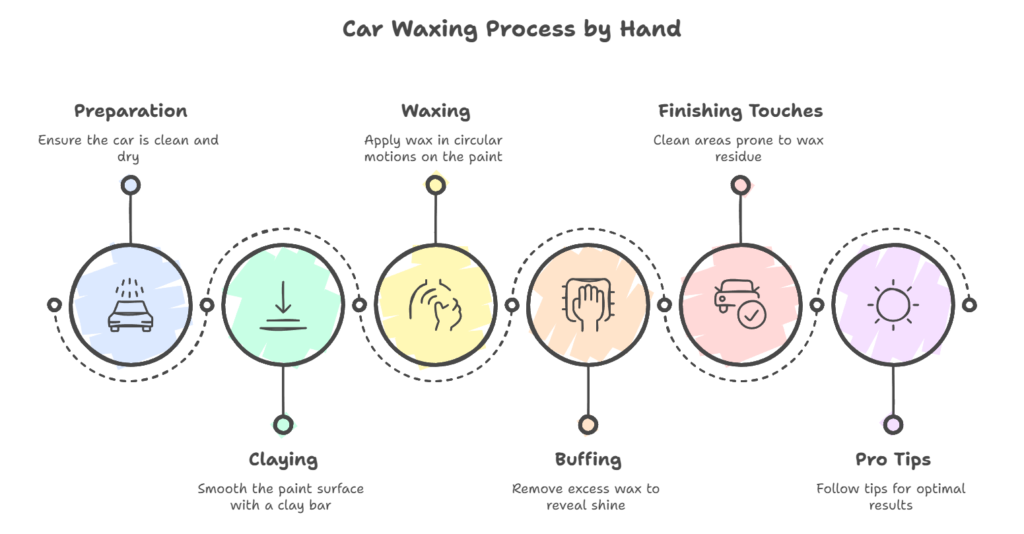Giving your car a good wax job isn’t just about aesthetics; it’s an essential part of protecting your vehicle’s paint and maintaining its value. The process itself can be a rewarding DIY project, offering a sense of accomplishment and saving you money compared to professional detailing services. Here’s a comprehensive guide on how to do car wax by hand, along with some pro tips for a flawless finish:

Materials:
- Car wash essentials:
- Waxing and detailing supplies:
- Clay bar (optional)
- Clay lubricant (optional)
- Car wax (choose a type based on your paint and desired finish)
- Applicator pad (foam or microfiber)
- Polishing pad (optional, for stubborn stains)
Instructions:
- Preparation is key: Before you intend to do car wax by hand, ensure your car is thoroughly clean. Wash it using the two-bucket method to remove dirt, grime, and any loose contaminants. This prevents you from accidentally buffing dirt into the paint, which can cause scratches. Dry the car completely with a clean microfiber towel to avoid water spots.
- Claying for an extra-smooth finish (optional): If your paint feels rough to the touch, even after washing, claying can be a game-changer. Claying involves gently gliding a clay bar lubricated with a special solution over the paint to remove embedded contaminants like tar, rail dust, and industrial fallout that washing alone might miss. This step ensures a perfectly smooth surface for the wax to adhere to, maximizing its effectiveness and creating a mirror-like shine.
- Waxing like a pro: Now comes the fun part! Apply a small amount of wax to the applicator pad and work it onto the car’s paint in small sections using circular motions. Opt for a thin and even layer; more wax isn’t necessarily better. Remember, you can always add more coats for additional protection, but applying too much wax initially can make buffing it off more difficult.
- Buffing to perfection: Once you’ve covered a section, use a clean microfiber towel to buff the wax off, revealing a deep shine. Buffing removes any excess wax and ensures an even application. Work in small sections at a time, frequently flipping the towel to a clean side to prevent transferring any wax residue back onto the paint.
- The finishing touches: Pay close attention to areas like trim, moldings, and around emblems. These areas are prone to accumulating wax residue, which can leave unsightly white marks. Use a clean microfiber towel to gently buff away any residue in these areas.
Pro Tips:
Car wax by hand is a very simple process but to get the ultimate results below are some of the pro tips to get the job done.
- Work in a cool, shaded area: Direct sunlight can cause the wax to dry too quickly, making it difficult to buff off evenly. Aim for a well-ventilated space out of direct sun for optimal working conditions.
- Don’t skimp on the towels: Having a good supply of clean microfiber towels is crucial. Using dirty or worn towels can scratch the paint and leave streaks.
- Choose the right wax for your car: Different waxes offer varying levels of protection, shine, and durability. Consider factors like your car’s paint type, desired finish, and climate when selecting a wax.
- Be gentle: Apply minimal pressure while washing, claying, and buffing to avoid scratching the paint.
- Store leftover wax properly: Keep leftover wax in a cool, dry place for future use.
Is it good to hand wax your car?
Absolutely. It is still the most efficient way to wax your car. Waxing by hand will give your car Paint Protection, Enhanced Shine, Reduced Minor Scratches and Swirl Marks and better resale value. The only downside is that it will take a little extra time to get it done and that too depends on the size of your vehicle.
Is it better to wet wax or dry wax a car?
The choice between “wet waxing” and “dry waxing” a car comes down to the type of product being used and the desired outcome. Dry waxing is more time consuming but results are superior shine and better paint protection. Wet waxing takes less time easier to do but results are quite mediocre.



